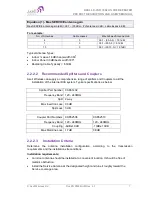
AXELL D-CSR 3302 US VHF REPEATER
PRODUCT DESCRIPTION AND US
ER’S MANUAL
IV
DOC PN 0034B-UM REV. 2.1
© Axell Wireless Ltd
Part 90 Signal Boosters
THIS IS A 90.219 CLASS A DEVICE
WARNING:
This is
NOT
a
CONSUMER
device. This device is designed for installation
by
FCC LICENCEES
and
QUALIFIED INSTALLERS
. You
MUST
have an
FCC
LICENCE
or express consent of an FCC Licensee to operate this device.
You
MUST
register Class B signal boosters (as defined in 47 CFR 90.219) online at
www.fcc.gov/signal-boosters/registration
.
Unauthorized use may result in significant forfeiture penalties, including penalties in
excess of $100,000 for each continuing violation.
The installation procedure must result in the signal booster complying with FCC
requirements 90.219(d). In order to meet FCC requirements
90.219 (d),
it may be
necessary for the installer to reduce the UL and/or DL output power for certain
installations.
This device complies with part 15 of the FCC Rules. Operation is subject to the following
two conditions:
1. This device may not cause harmful interference, and
2. This device must accept any interference received, including interference that may
cause undesired operation.
If not installed and used in accordance with the instructions, this equipment generates, uses
and can radiate radio frequency energy. However, there is no guarantee that interference
will not occur in a particular installation. If this equipment does cause harmful interference to
RF reception, which can be determined by turning the equipment off and on, the user is
encouraged to try to correct the interference by one or more of the following measures:
Reorient or relocate the Donor antenna.
Increase the separation between the equipment and receiver.
Connect the equipment into an outlet on a circuit different from that to which the
receiver is connected.
Changes or Modifications not expressly approved by the manufacturer responsible for
compliance could void the user’s authority to operate the equipment
This unit complies with FCC RF exposure limits for an uncontrolled environment. This
equipment can only be installed in in-building applications, driving passive or active DAS
systems. All antennas must be operated at a minimum distance of 58 cm between the
radiator and any person’s body.





































